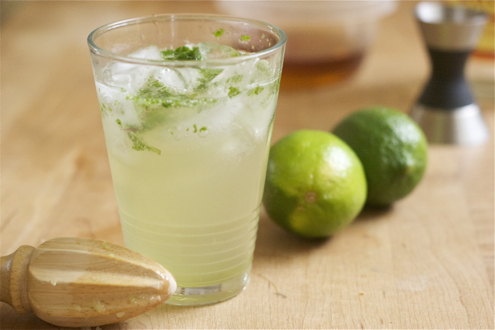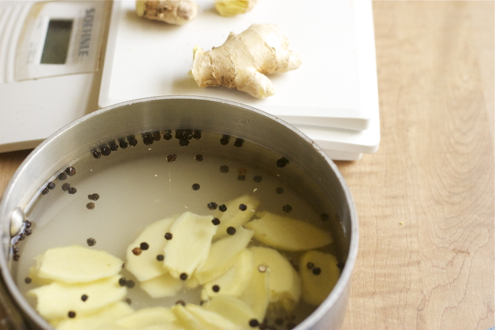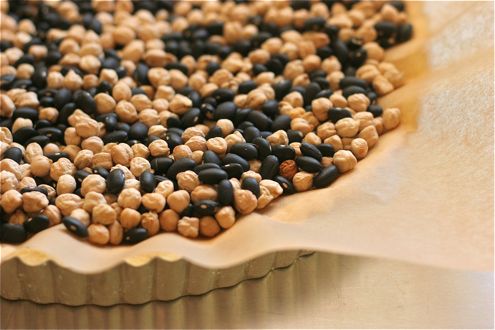Better late than never? I hope so. I almost survived Christmas. I could not finagle a single minute to write even a little line or take one yellow-cast nighttime photo. Oh well, I can’t stand those dim candlelit dinner photos anyway.
Right now, I am hunkering down on the couch with a blanket and my laptop. Outside it is neither bright and crisply cold nor white with snow. My hand is deep in one of the many little bags of cookies my sister dropped off for Christmas. You would not believe it. Cardamom horns, chocolate nib shortbreads, chocolate sparklers, chewy ginger cookies, teeny tiny chocolate marshmallows AND (!!!) pecan chocolate dipped butter toffee. They are so gorgeously packed up – each in its own small cellophane bag with a little printed label. I should have taken a picture. (I would accuse her of showboating but I could never jeopardize her taking me off her delivery list!!! Yes. They are that good. I may have to make her write a guest post sometime in November 2013.) I digress. I am so wiped out by Christmas I can barely move. I am just sitting around eating cookies, contemplating how on earth I can get up the energy to make something decent for dinner for the ravenous hoards. (aka my children)
Part of the reason for this slothfulness is that the weather is so particularly Seattle-ish. The mercury hovers around 40 during the day, dipping down to within 3 or 4 degrees of freezing at night. I am dying for a little snow but this will not be the year for it. It’s bleak, that’s what it is. A good time for a nap on the couch, slipping in and out of sleep with a good book. Like a cookbook. I have two new ones here, which are making for a fine escape from this dreary weather. Ottolenghi’s Jerusalem, so warmly Mediterranean and Screen Doors And Sweet Tea, a gift from my very dear friend Alicia. I’m making the Sweet Potato Biscuits for a party tomorrow, New Year’s Day, to go with baked ham and scallopped potatoes and, for tonight, the open kibbeh pie from Jerusalem. Well actually my neighbor is making the pie. But I will be eating it! With a spinach salad with dates and almonds from the same book. Toasting for peace in the Middle East on New Year’s Eve! (and celebrating my newest Ottolenghi cookbook – naturally!)
Even though the recipes are shockingly late, please give my Christmas dinner a try anyway. It would make for a thrilling Valentine’s Day dinner party. In those carvery-sort of restaurants where you often find a French dip sandwich, every component is mediocre. Often, you get some sort of feed lot slab of beef, a salty chemical jus from a jug, a limp roll, maybe slightly stale. Certainly no onion jam. And they aren’t buttering that bread with French butter. I bought my tenderloin at Rainshadow Meats, my local butcher, so I know it’s responsibly sourced. I caramelized onions for an onion jam. I made crème fraîche and swirled in a little horseradish. Even though nearly every method for French dip online calls for canned beef broth, I made my own. The seasonings on the beef might seem unusual. Fennel veers away from your run-of-the-mill French dip. Be brave! The delicate licorice notes only add to more usual thyme and black pepper! It is not a misstep or excessive in any way. None of the parts of this sandwich take much in the way of time, skill or effort. The work is minimal considering many people consider Christmas dinner to be the highpoint of the year. This small amount of work pays off in a big way.
The sandwich photos were taken the day after Christmas, without jus, as we’d dipped it all up the previous day. The leftover French dip lost nothing overnight. We hardly missed dunking into hot peppery broth.
Top Shelf French Dip Sandwiches – for 8, with leftovers
The Components:
The day before Christmas:
Season the Beef (somewhat adapted from this recipe from Fine Cooking)
- 4 Tbs. extra-virgin olive oil
- 4 Tbs. finely chopped fresh thyme
- 2 Tbs. ground fennel seed
- 2 tbsp Kosher salt
- Freshly cracked black pepper
- (1) 4 pound beef tenderloin, trimmed and tied. If the roast includes the tapered end of the roast, fold it under and tie it in place so that the roast is the same diameter for the entire length
- Dry the tenderloin with paper towels. Combine the olive oil, thyme, fennel seed, salt and pepper and rub all over the tenderloin. If you can do this the day before and keep the roast lightly covered in parchment in the refrigerator overnight, so much the better.
Crème fraîche
- 2 cups heavy cream
- 1/4 cup buttermilk
- Whisk cream and buttermilk together in a heavy medium sized bowl.
- Cover with plastic wrap.
- Set in a warm spot for 24 hours.
- If the cream doesn’t thicken, it probably wasn’t warm enough. You can set the cream in a warmer spot for a further 24 hours. I set mine on top of the stove as we were baking in the oven below at 475. It worked perfectly. The following morning the cream was very thick.
Jus
- 6 cups veal stock
- 1 tbsp soy sauce or Worcestershire
- splash of sherry
- sea salt and plenty of freshly ground black pepper
- Reduce veal stock by half over medium high heat
- Add soy sauce or Worcestershire, sherry and salt and pepper to taste.
- Keep warm over low heat.
- Remove the beef from the refrigerator and let sit at room temperature for an hour before roasting.
- Half an hour before you want to start the beef, preheat the oven to 375°F.
- Place the tenderloin on a wire rack on a large rimmed baking sheet.
- Roast to 130°F for medium rare, or 135°F for medium, 40 to 50 minutes. I recommend a digital oven thermometer so you can plug it in and walk away. There is enough going on at Christmas without having to worry about whether you are over cooking the roast or not.
- When the roast has reached temperature, allow to rest uncovered on a carving board for 10 minutes. Slice very thinly. (Make sure all the other ingredients are prepped before you start! Don’t let the meat get cold)
Horseradish Cream
- 1 cup crème fraîche
- several tablespoons prepared horseradish, newly opened
16 good quality sandwich rolls
- Preheat the oven to 200.
- Wrap rolls tightly in foil and warm in the oven for 15 minutes.
- Slice in half for sandwiches.
To assemble:
- Spread the warm rolls with unsalted French butter on both sides.
- After the meat has rested for at least 10 minutes, slice it as thinly as you can with your sharpest carving knife. I have one called Schinkenmesser (it means ham slicer) and it is nicely flexible and carves beautifully.
- Pile many slices onto each sandwich – you will have to judge how much. I would say at least 10 slices per sandwich for the grown-ups.
- On top of the meat spread 2 or 3 tablespoons of the caramelized onions. And on top of that, 2 or 3 tablespoons of horseradish cream.
- Serve with about 1/2 a cup of steaming jus in a small ramekin on the side.
These sandwiches are excessive in every way. Even so, people will eat seconds. It is quite possible that dessert will get the short shrift.


























